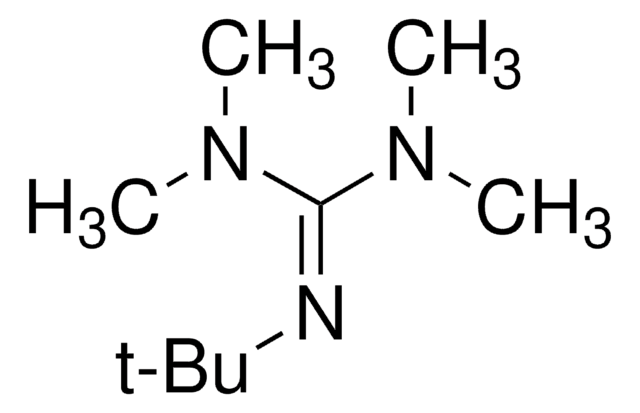86890
Tetrabutylammonium iodide
≥99.0% (AT)
Synonym(s):
TBAI
Sign Into View Organizational & Contract Pricing
All Photos(1)
About This Item
Linear Formula:
(CH3CH2CH2CH2)4N(I)
CAS Number:
Molecular Weight:
369.37
Beilstein/REAXYS Number:
3916152
EC Number:
MDL number:
UNSPSC Code:
12352107
PubChem Substance ID:
NACRES:
NA.22
Recommended Products
Quality Level
assay
≥99.0% (AT)
form
crystals
mp
141-143 °C (lit.)
SMILES string
[I-].CCCC[N+](CCCC)(CCCC)CCCC
InChI
1S/C16H36N.HI/c1-5-9-13-17(14-10-6-2,15-11-7-3)16-12-8-4;/h5-16H2,1-4H3;1H/q+1;/p-1
InChI key
DPKBAXPHAYBPRL-UHFFFAOYSA-M
Looking for similar products? Visit Product Comparison Guide
Related Categories
General description
Tetrabutylammonium iodide is a quaternary ammonium salt used in phase-transfer reactions. It is also used in regioselective ether cleavage reactions and as a source of iodide for nucleophilic displacement reactions.
Application
Tetrabutylammonium iodide can be used:
- As an additive in the synthesis of fused triazole derivatives using palladium catalyst.
- To prepare allyl-PEG-allyl, which is a key intermediate polymer used to synthesize fluorinated amphiphilic copolymers.
- As a catalyst used in the synthesis of ethers.
signalword
Warning
hcodes
Hazard Classifications
Acute Tox. 4 Oral - Eye Irrit. 2 - Skin Irrit. 2
Storage Class
11 - Combustible Solids
wgk_germany
WGK 2
flash_point_f
Not applicable
flash_point_c
Not applicable
ppe
dust mask type N95 (US), Eyeshields, Gloves
Choose from one of the most recent versions:
Already Own This Product?
Find documentation for the products that you have recently purchased in the Document Library.
Customers Also Viewed
J.M. Chong et al.
The Journal of Organic Chemistry, 52, 2596-2596 (1987)
S. Czernecki et al.
Tetrahedron Letters, 3535-3535 (1976)
Chao Zhong et al.
Carbohydrate polymers, 94(1), 38-45 (2013-04-03)
In this article, a novel and high efficient solvent, tetra-n-Butylammonium Hydroxide (TBAH), was used for dissolution and isolation of straw cellulose from wheat straw. The composition analysis with gas chromatography (GC) and the spectroscopic characterization analysis conducted by X-Ray diffraction
R Bryan Sears et al.
Journal of inorganic biochemistry, 121, 77-87 (2013-01-29)
The complex cis-[Ru(phpy)(phen)(CH3CN)2](+) (phpy=2-phenylpyridine, phen=1,10-phenanthroline) was investigated as a potential photodynamic therapy (PDT) agent. This complex presents desirable photochemical characteristics including a low energy absorption tail extending into the PDT window (600-850nm) and photoinduced exchange of the CH3CN ligands, generating
Oliver Bixner et al.
The Journal of chemical physics, 136(20), 204503-204503 (2012-06-07)
The interaction of exciton and charge transfer (CT) states plays a central role in photo-induced CT processes in chemistry, biology, and physics. In this work, we use a combination of two-dimensional electronic spectroscopy (2D-ES), pump-probe measurements, and quantum chemistry to
Our team of scientists has experience in all areas of research including Life Science, Material Science, Chemical Synthesis, Chromatography, Analytical and many others.
Contact Technical Service



![1,8-Diazabicyclo[5.4.0]undec-7-ene 98%](/deepweb/assets/sigmaaldrich/product/structures/120/564/5b373e23-1624-489c-8efb-692de0f96ffb/640/5b373e23-1624-489c-8efb-692de0f96ffb.png)







![Bis[(tetrabutylammonium iodide)copper(I) iodide] 95%](/deepweb/assets/sigmaaldrich/product/structures/339/974/1a5949b3-c4f6-42ec-9ab5-4888c40dbd1b/640/1a5949b3-c4f6-42ec-9ab5-4888c40dbd1b.png)